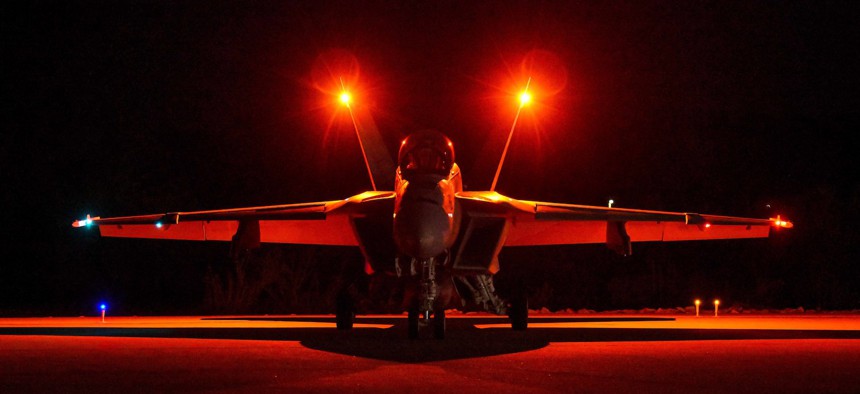
An F/A-18 Super Hornet, assigned to the “Gladiators” of Strike Fighter Squadron (VFA) 106, taxis the flight line on Naval Air Station Oceana in 2021. U.S. Navy / Mass Communication Specialist 2nd Class Megan Wollam
Defense Business Brief: End of Super Hornet production nears; New Navy hospital ships; Leidos names new CEO; and more.
The end of F/A-18 Super Hornet production is rapidly approaching, according to jet-maker Boeing. The company has set the end date as “late 2025,” but could end up building planes at its St. Louis factory until 2027 if India purchases the jet.
This should come as no surprise, as Boeing had penciled in the end of the Super Hornet—and its F-15 fighter—by 2020. But both lines are still active thanks to additional U.S. military orders. Internationally, the F-35 stealth fighter has run the table in recent competitions against the Super Hornet. Switzerland, Finland, and Canada all went with the F-35, and Germany, which was planning to buy EA-18G Growlers, an electronic attack version of the Super Hornet jointly manufactured by Boeing and Northrop Grumman, opted to go with the F-35 after Russia invaded Ukraine last year.
India remains among the last possible buyers of the F/A-18.
“We doubt India buys it for its aircraft carrier, but the program’s end may not be material for Boeing or Northrop Grumman,” Capital Alpha Partners’ Byron Callan wrote in a Feb. 26 note to clients.
But while announcing the projected end of Super Hornet production, Boeing again stressed that the company wants to build new generation combat aircraft.
“We are planning for our future, and building fighter aircraft is in our DNA,” Steve Nordlund, Boeing Air Dominance vice president and St. Louis site leader, said in a statement. “As we invest in and develop the next era of capability, we are applying the same innovation and expertise that made the F/A-18 a workhorse for the U.S. Navy and air forces around the world for nearly 40 years.”
Boeing says it has hired more than 900 people in the St. Louis region, where it also builds F-15s, T-7 pilot training jets, and MQ-25 refueling drones. The company “plans to continue hiring year-over-year for the next five at its St. Louis site.”
Boeing plans to invest more than $1 billion into its sites in the St. Louis region, including “three new, state-of-the-art facilities.” In addition, the existing fleet of Super Hornets will need service life modifications and other upgrades.
Welcome
You’ve reached the Defense Business Brief by Marcus Weisgerber. Send along your tips and feedback to mweisgerber@defenseone.com or @MarcusReports. Check out the Defense Business Brief archive here, and tell your friends to subscribe!
NEW TODAY: Leidos named Rolls-Royce executive Tom Bell its next CEO, effective May 3. He will replace Roger Krone, who has led the technology company since 2014. Bell is the president of Rolls-Royce defense, and CEO of Rolls-Royce North America. He and Krone previously worked together at Boeing.
The Navy christened USNS Cody, an Expeditionary Fast Transport with new medical facilities being touted as a “quantum leap for our capabilities afloat,” according to Navy Surgeon General Rear Adm. Bruce Gillingham.
“What this ship represents is incredible agility and flexibility in meeting our mission—and particularly as we envision potentially highly complex conflict in the future, on the water,” Gillingham said at the ship’s christening on Saturday.
Cody is the 14th Expeditionary Fast Transport built by shipmaker Austal USA in Mobile, Alabama. The ship has two operating rooms and an intensive care unit. Osprey tiltrotor aircraft can land on the deck to transport patients or supplies..
“The speed of this will allow us to get into places and out quickly and to be able to hopefully come to the aid of both Marines and sailors should they become injured,” Gillingham said.
The smaller ships will also allow the Navy to go to new locations around the world that its larger hospital ships, Mercy and Comfort, cannot sail.
“This ship will give us additional ability to do humanitarian missions, which we think is a great use, and a great investment for our country to be able to strengthen our partnership with host nations,” Gillingham said.
Each ship will have a crew of about 100 doctors, nurses, surgeons, and various technicians, known as an expeditionary medical unit. Austal is building two more Expeditionary Fast Transports, which like Cody have added medical capabilities. The company will then build three additional ships that will be “fully dedicated to the medical mission,” said Larry Ryder, Austal’s vice president of business development.
“The smaller, more distributed capabilities, I think, are more in line with where the Navy's going operationally,” Ryder said. “We think there's a long road ahead of us on ships like this.”
Pratt & Whitney can resume deliveries of F135 engines to F-35 stealth fighter manufacturer Lockheed Martin following a December crash, the Pentagon said. Officials have been working “to understand and develop mitigations for a rare system phenomenon involving harmonic resonance to develop a path forward for safe operation of the F135 in flight,” the F-35 program official said in an emailed statement. “The actions the government and industry team are taking will ensure incorporation of mitigation measures that will fully address/resolve this rare phenomenon in impacted F135 engines.”
Lockheed Martin announced that Christian Marrone, its senior vice president for government affairs, resigned last week, effective Tuesday, “for personal reasons.” Greg Walters, vice president of legislative affairs, has been named acting senior vice president for government affairs. Marrone, a former top aide to Defense Secretary Robert Gates and chief of staff to Homeland Security Jeh Johnson, a Lockheed board member, was named Lockheed’s head of government affairs in mid-2021. Last year, he was in the center of a brouhaha between Lockheed and the Aerospace Industries Association, an influential aerospace and defense trade group.




